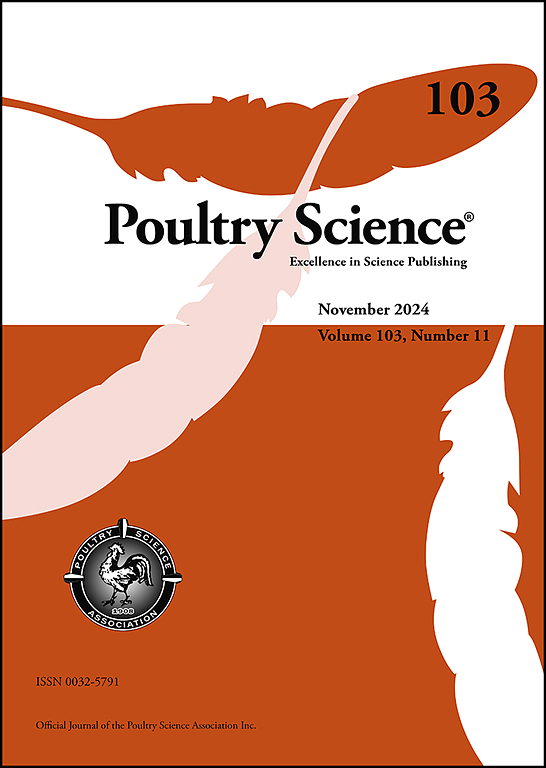过氧乙酸(PAA)对鸡皮肤和食物接触表面的鼠伤寒沙门氏菌的抑菌效果优于氯基消毒剂
IF 4.2
1区 农林科学
Q1 AGRICULTURE, DAIRY & ANIMAL SCIENCE
引用次数: 0
摘要
沙门氏菌的爆发,特别是在家禽业,对食品安全和公共卫生构成重大挑战。广泛使用的消毒剂,包括二氧化氯(ClO2)和次氯酸钠(NaOCl)等氯基消毒剂,特别是对细菌生物膜的作用有限,往往会加剧这些疫情。在食物接触表面形成的生物膜使沙门氏菌免受消毒剂的污染,导致持续污染和抵抗力增强,强调需要更有效的消毒策略。本研究旨在评价和比较过氧乙酸(PAA)与ClO2和NaOCl对不同食品接触表面(包括不锈钢、塑料、硅橡胶和鸡皮)伤寒沙门菌的杀菌和抗菌效果。PAA显示出最高的杀菌和抗菌效果,即使在有机负载丰富的环境中,也需要比ClO2和NaOCl更低的浓度。共聚焦显微镜和蛋白质渗漏实验表明,PAA可诱导鼠伤寒沙门氏菌浮游细胞的细胞壁破坏,而ClO2和NaOCl在相同条件下效果较差。这些结果表明,PAA是控制家禽加工设施沙门氏菌的较好选择,在加工设施卫生方面具有更大的适用性,以提高整体食品安全。本文章由计算机程序翻译,如有差异,请以英文原文为准。
Peracetic acid (PAA) exhibits higher antimicrobial efficacy compared to chlorine-based disinfectants against Salmonella Typhimurium on chicken skin and food-contact surfaces
Outbreaks of Salmonella, especially in the poultry industry, pose significant food safety and public health challenges. These outbreaks are often intensified by the limited effectiveness of widely used disinfectants, including chlorine-based agents like chlorine dioxide (ClO2) and sodium hypochlorite (NaOCl), particularly against bacterial biofilms. Biofilm formation on food-contact surfaces shields Salmonella from sanitizers, leading to persistent contamination and increased resistance, emphasizing the need for more effective disinfection strategies. This study aimed to evaluate and compare the bactericidal and antibiofilm efficacy of peroxyacetic acid (PAA) with ClO2 and NaOCl against Salmonella enterica serovar Typhimurium (S. Typhimurium) on various food-contact surfaces, including stainless steel, plastic, silicon rubber, and chicken skin. PAA demonstrated the highest bactericidal and antibiofilm effectiveness, requiring lower concentrations than ClO2 and NaOCl, even in organic load-rich environments. Confocal microscopy and protein leakage assays demonstrated that PAA induces significant cell wall disruption of S. Typhimurium planktonic cells, unlike ClO2 and NaOCl, which were less effective under similar conditions. These findings suggest that PAA is a superior alternative for controlling Salmonella in poultry processing facilities, offering greater applicability for sanitation in processing facilities to enhance overall food safety.
求助全文
通过发布文献求助,成功后即可免费获取论文全文。
去求助
来源期刊

Poultry Science
农林科学-奶制品与动物科学
CiteScore
7.60
自引率
15.90%
发文量
0
审稿时长
94 days
期刊介绍:
First self-published in 1921, Poultry Science is an internationally renowned monthly journal, known as the authoritative source for a broad range of poultry information and high-caliber research. The journal plays a pivotal role in the dissemination of preeminent poultry-related knowledge across all disciplines. As of January 2020, Poultry Science will become an Open Access journal with no subscription charges, meaning authors who publish here can make their research immediately, permanently, and freely accessible worldwide while retaining copyright to their work. Papers submitted for publication after October 1, 2019 will be published as Open Access papers.
An international journal, Poultry Science publishes original papers, research notes, symposium papers, and reviews of basic science as applied to poultry. This authoritative source of poultry information is consistently ranked by ISI Impact Factor as one of the top 10 agriculture, dairy and animal science journals to deliver high-caliber research. Currently it is the highest-ranked (by Impact Factor and Eigenfactor) journal dedicated to publishing poultry research. Subject areas include breeding, genetics, education, production, management, environment, health, behavior, welfare, immunology, molecular biology, metabolism, nutrition, physiology, reproduction, processing, and products.
 求助内容:
求助内容: 应助结果提醒方式:
应助结果提醒方式:


